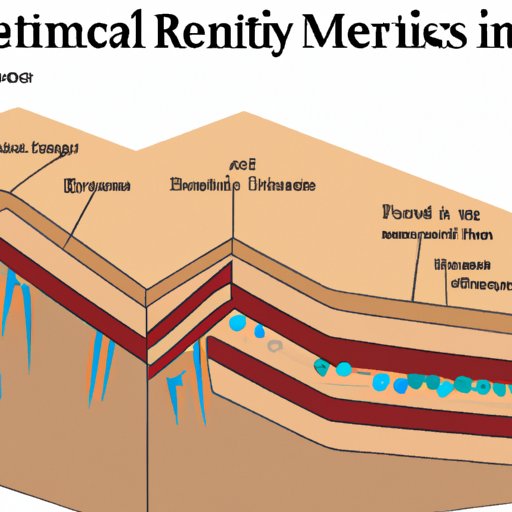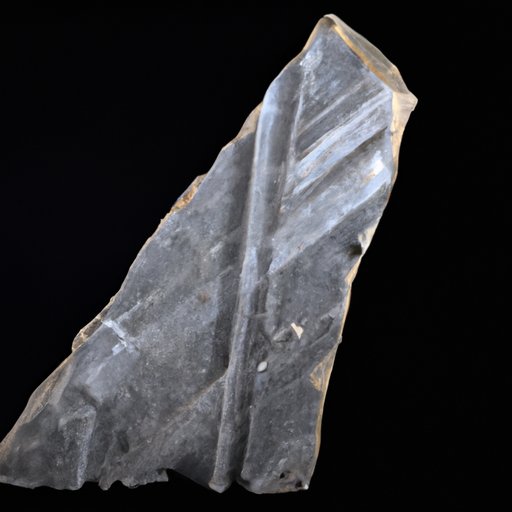Introduction
Mineral cleavage is one of the fundamental properties of minerals, and it plays an important role in mineral identification, classification, and the mineral industry. Understanding what mineral cleavage is and how it works is essential for geologists, mineralogists, and anyone who works with minerals. This article provides a comprehensive guide to mineral cleavage, covering the basics of how minerals break along planes, an exploration of the science behind cleavage, and the use of cleavage in mineral identification and classification.
An Introduction to Mineral Cleavage: What It Is and Why It Matters
Mineral cleavage is the tendency of some minerals to break along smooth, flat surfaces, or cleavage planes. This occurs because of the arrangement of atoms within the crystal structure of minerals, which determines how the mineral breaks. Understanding mineral cleavage is important because it can help identify minerals and distinguish them from one another. Different minerals exhibit different types of cleavage, and careful observation of cleavage planes can reveal important characteristics of a mineral.
In this section, we will examine the different types of mineral cleavage and provide examples of minerals that exhibit these types of cleavage. We will also discuss the difference between cleavage and fracture, which is another way minerals can break.

Exploring the Basics of Mineral Cleavage: How Minerals Break Along Planes
Minerals break along certain planes because of the arrangement of atoms within the crystal structure. When a mineral is subjected to stress, such as pressure or a blow, it will break along the path of least resistance, which is determined by the orientation of the atoms in the crystal structure. Cleavage occurs when the mineral breaks along smooth, flat surfaces parallel to crystal faces.
Fracture, on the other hand, occurs when a mineral breaks in a way that is not along a cleavage plane. Fracture can be conchoidal, like the way glass breaks, or uneven, like the way some rocks break. Unlike cleavage, which is determined by the crystal structure, fracture is determined by the physical properties of the mineral’s bonds.
Examples of minerals that exhibit fracture include quartz, which breaks in a conchoidal fashion, and galena, which breaks along cubic cleavage planes but can also exhibit uneven fracture.
The Science Behind Mineral Cleavage: Understanding This Fundamental Mineral Property
The geological and chemical processes that create minerals also determine their properties, including cleavage. Cleavage occurs when mineral bonds along certain planes are weaker than others, which is a result of the mineral’s crystal structure. Some minerals have perfect cleavage, which means they break easily along specific planes, while others have imperfect cleavage, which means they require more force to break along certain planes.
The crystal structure of a mineral can be described by its lattice system and crystal habit. The lattice system determines the symmetry of the crystal structure and is divided into seven crystal systems, including cubic, tetragonal, orthorhombic, monoclinic, and triclinic. The crystal habit describes the shape of the crystal and can vary depending on the conditions under which the mineral forms.
The combination of the lattice system and crystal habit can help explain why some minerals exhibit certain types of cleavage. For example, galena, which has a cubic lattice system, exhibits cubic cleavage, or cleavage planes that are perpendicular to each other.
Mineral Cleavage: A Vital Tool for Mineral Identification and Classification
Cleavage is a valuable tool for mineral identification because it is a characteristic property of minerals. By observing the way a mineral breaks along certain planes, geologists and mineralogists can identify the mineral and distinguish it from other minerals that may look similar.
Cleavage is also an important property for mineral classification because it helps organize minerals into groups based on their crystal structures and physical properties. For example, minerals that exhibit cubic cleavage, such as halite and fluorite, belong to the cubic crystal system and have similar physical properties.
Cleavage can also help distinguish minerals that may have similar physical properties but different crystal structures. For example, hematite and magnetite are both iron ores that have similar appearances and physical properties, but hematite has no cleavage while magnetite exhibits octahedral cleavage.
Unlocking the Mysteries of Mineral Cleavage: A Comprehensive Guide
Mineral cleavage is a complex property that depends on many factors, including the mineral’s crystal structure, lattice system, and crystal habit. In this section, we will provide a detailed explanation of the different types of mineral cleavage, including basal, prismatic, pinacoidal, and rhombohedral cleavage. We will also describe the seven crystal systems and how they affect cleavage. Finally, we will explain how cleavage is measured and described using the Miller indices system.
Discovering the World of Mineral Cleavage: How It Shapes the Mineral Industry
The knowledge of mineral cleavage plays a significant role in the mineral industry. For example, the extraction and processing of minerals can be affected by their cleavage properties. Cleavage can affect the ease with which minerals can be mined or processed. Minerals with perfect cleavage have planes of weakness that can be exploited to extract them from the ground or separate them from other minerals.
Understanding mineral cleavage can also lead to advances in the field of mineralogy. Knowing how minerals break can help scientists create new materials or improve existing ones. For example, scientists may be able to use knowledge of cleavage to create more durable materials or design better cutting tools.
Conclusion
Mineral cleavage is a fundamental property of minerals that plays an important role in both geology and industry. Understanding the different types of mineral cleavage, the science behind it, and its use in mineral identification and classification is essential for anyone who works with minerals. By knowing how minerals break and what determines their cleavage, we can gain a deeper understanding of their properties and potential uses.
If you are interested in learning more about mineral cleavage, there are many resources available, including textbooks, scientific journals, and online resources. By continuing to study and explore this fascinating property of minerals, you can deepen your understanding of the world around us.
(Note: Is this article not meeting your expectations? Do you have knowledge or insights to share? Unlock new opportunities and expand your reach by joining our authors team. Click Registration to join us and share your expertise with our readers.)
